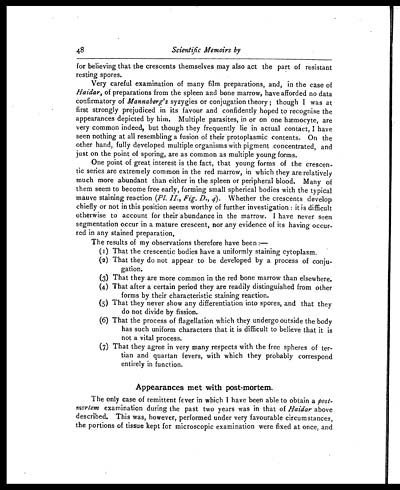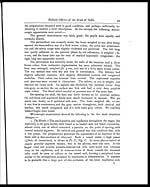Medicine - Institutions > Army health reports and medical documents > Scientific memoirs by medical officers of the Army of India > Part X, 1897 > 2 - Notes on the malarial parasite as observed in the blood during life, and in the tissues post-mortem, at Lahore, Punjab
(54) Page 48
Download files
Individual page:
Thumbnail gallery: Grid view | List view

48
Scientific Memoirs by
for believing that the crescents themselves may also act the part of resistant
resting spores.
Very careful examination of, many film preparations, and, in the case of
Haidar, of preparations from the spleen and bone marrow, have afforded no data
confirmatory of Mannaberg's syzygies or conjugation theory; though I was at
first strongly prejudiced in its favour and confidently hoped to recognise the
appearances depicted by him. Multiple parasites, in or on one hæmocyte, are
very common indeed, but though they frequently lie in actual contact, I have
seen nothing at all resembling a fusion of their protoplasmic contents. On the
other hand, fully developed multiple organisms with pigment concentrated, and
just on the point of sporing, are as common as multiple young forms.
One point of great interest is the fact, that young forms of the crescen-
tic series are extremely common in the red marrow, in which they are relatively
much more abundant than either in the spleen or peripheral blood. Many of
them seem to become free early, forming small spherical bodies with the typical
mauve staining reaction (Pl. II., Fig. D., 4 ). Whether the crescents develop
chiefly or not in this position seems worthy of further investigation: it is difficult
otherwise to account for their abundance in the marrow. I have never seen
segmentation occur in a mature crescent, nor any evidence of its having occur-
red in any stained preparation.
The results of my observations therefore have been:—
(1) That the crescentic bodies have a uniformly staining cytoplasm.
(2) That they do not appear to be developed by a process of conju-
gation.
(3) That they are more common in the red bone marrow than elsewhere.
(4) That after a certain period they are readily distinguished from other
forms by their characteristic staining reaction.
(5) That they never show any differentiation into spores, and that they
do not divide by fission.
(6) That the process of flagellation which they undergo outside the body
has such uniform characters that it is difficult to believe that it is
not a vital process.
(7) That they agree in very many respects with the free spheres of ter-
tian and quartan fevers, with which they probably correspond
entirely in function.
Appearances met with post-mortem.
The only case of remittent fever in which I have been able to obtain a post-
mortem examination during the past two years was in that of Haidar above
described. This was, however, performed under very favourable circumstances,
the portions of tissue kept for microscopic examination were fixed at once, and
Set display mode to: Large image | Zoom image | Transcription
Images and transcriptions on this page, including medium image downloads, may be used under the Creative Commons Attribution 4.0 International Licence unless otherwise stated. ![]()
| Permanent URL | https://digital.nls.uk/75003204 |
|---|
| Shelfmark | IP/QB.10 |
|---|---|
| Additional NLS resources: | |




